
The Battle of Marengo was fought on 14 June 1800 between French forces under the First Consul Napoleon Bonaparte and Austrian forces near the city of Alessandria, in Piedmont, Italy. Near the end of the day, the French overcame General Michael von Melas' surprise attack, drove the Austrians out of Italy and consolidated Bonaparte's political position in Paris as First Consul of France in the wake of his coup d'état the previous November.
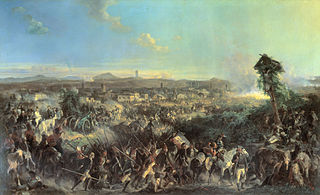
The Battle of Novi saw a combined army of the Habsburg monarchy and Imperial Russians under Field Marshal Alexander Suvorov attack a Republican French army under General Barthélemy Catherine Joubert. As soon as Joubert fell during the battle, Jean Victor Marie Moreau immediately took overall command of the French forces. After a prolonged and bloody struggle, the Austro-Russians broke through the French defenses and drove their enemies into a disorderly retreat, while French division commanders Catherine-Dominique de Pérignon and Emmanuel Grouchy were captured. Novi Ligure is in the province of Piedmont in Northern Italy a distance of 58 kilometres (36 mi) north of Genoa. The battle occurred during the War of the Second Coalition which was part of the French Revolutionary Wars.
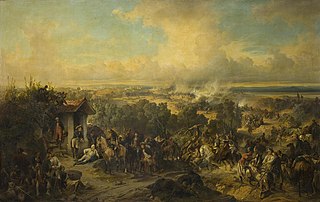
The Battle of (the) Trebbia was fought near the rivers of Tidone, Trebbia, and Nure in northern Italy between the joint Russian and Habsburg army under Alexander Suvorov and the Republican French army of Étienne-Jacques-Joseph-Alexandre Macdonald. Though the opposing armies were approximately equal in total numbers, the Austro-Russians severely defeated the French, sustaining about 5,500 casualties while inflicting losses of 16,500 on their enemies. The War of the Second Coalition engagement occurred west of Piacenza, a city located 70 kilometres (43 mi) southeast of Milan.

The Battle of Abensberg took place on 20 April 1809 between a Franco-German force under the command of Emperor Napoleon I of France and a reinforced Austrian corps led by Feldmarschall-Leutnant Archduke Louis of Austria. As the day wore on, Feldmarschall-Leutnant Johann von Hiller arrived with reinforcements to take command of the three corps that formed the Austrian left wing. The action ended in a complete Franco-German victory. The battlefield was southeast of Abensberg and included clashes at Offenstetten, Biburg-Siegenburg, Rohr in Niederbayern, and Rottenburg an der Laaber. On the same day, the French garrison of Regensburg capitulated.

The Battle of Cassano was fought in 1799 from 27 to 28 April near Cassano d'Adda, which about 28 km (17 mi) ENE of Milan. The clash is part of the battle of the Adda River or the so-called forcing of the Adda, which on the first day of 26 April resulted in a minor victory for the Russians under the Count Suvorov over Barthélemy Schérer's French forces at Lecco. Then, on the second day, Suvorov's Austrians and Cossacks prevailed over Jean Moreau's army, who replaced Schérer as supreme commander, and trapped his isolated division on the third. The action took place during the War of the Second Coalition, as part of the larger conflict known as the French Revolutionary Wars.
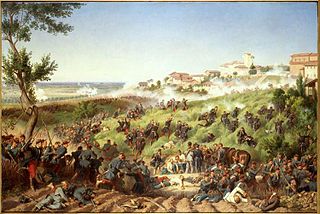
The Battle of Montebello was fought on 20 May 1859 at Montebello. It was a minor engagement of the Second Italian War of Independence, fought between Piedmontese cavalry and French infantry against Austrian troops. Because of this battle, the Austrian commander-in-chief was obliged to keep some troops to cover the southern part of the front.

The Battle of Elchingen, fought on 14 October 1805, saw French forces under Michel Ney rout an Austrian corps led by Johann Sigismund Riesch. This defeat led to a large part of the Austrian army being invested in the fortress of Ulm by the army of Emperor Napoleon Bonaparte of France while other formations fled to the east. Soon afterward, the Austrians trapped in Ulm surrendered and the French mopped up most of the remaining Austrian forces, bringing the Ulm Campaign to a close.

The Battle of Teugen-Hausen or the Battle of Thann was an engagement that occurred during the War of the Fifth Coalition, part of the Napoleonic Wars. The battle was fought on 19 April 1809 between the French III Corps led by Marshal Louis-Nicolas Davout and the Austrian III Armeekorps commanded by Prince Friedrich Franz Xaver of Hohenzollern-Hechingen. The French won a hard-fought victory over their opponents when the Austrians withdrew that evening. The site of the battle is a wooded height approximately halfway between the villages of Teugn and Hausen in Lower Bavaria, part of modern-day Germany.

The Battle of Ebelsberg, known in French accounts as the Battle of Ebersberg, was fought on 3 May 1809 during the War of the Fifth Coalition, part of the Napoleonic Wars. The Austrian left wing under the command of Johann von Hiller took up positions at Ebersberg on the Traun river. The French under André Masséna attacked, crossing a heavily defended 550-meter-long bridge and subsequently conquering the local castle, thus forcing Hiller to withdraw. Ebelsberg is now a southern suburb of Linz, situated on the south bank of the Traun, a short distance above the place where that stream flows into the Danube River.
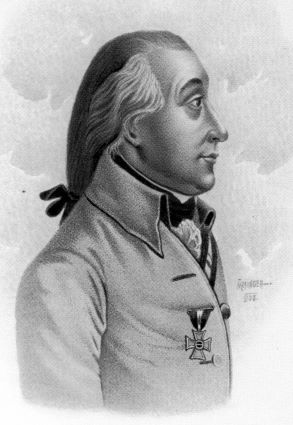
Peter Karl Ott von Bátorkéz was a military officer in the armies of the Habsburg monarchy. Of Hungarian origin, Ott fought in the wars against the Kingdom of Prussia, Ottoman Turkey, and the First French Republic in the last half of the 18th century. During the French Revolutionary Wars, he rose in rank to general officer and twice campaigned against the army of Napoleon Bonaparte in Italy. He played a key role in the Marengo campaign in 1800. He was Proprietor (Inhaber) of an Austrian Hussar regiment from 1801 to 1809.

The Battle of Lonato was fought on 3 and 4 August 1796 between the French Army of Italy under General Napoleon Bonaparte and a corps-sized Austrian column led by Lieutenant General Peter Quasdanovich. A week of hard-fought actions that began on 29 July and ended on 4 August resulted in the retreat of Quasdanovich's badly mauled force. The elimination of Quasdanovich's threat allowed Bonaparte to concentrate against and defeat the main Austrian army at the Battle of Castiglione on 5 August. Lonato del Garda is located near the SP 668 highway and the Brescia-Padua section of Autostrada A4 to the southwest of Lake Garda.
In the Battle of Fleurus Jean-Baptiste Jourdan's French army repulsed an attack by the combined Austro-Dutch army led by Prince Josias of Saxe-Coburg-Saalfeld. Tactically the battle was a draw but strategically it was a decisive French victory. The battle led to the collapse of the Coalition position in the Austrian Netherlands.
In the Battle of Rivoli on 14 and 15 January 1797, the French Army of Italy led by Napoleon Bonaparte crushed the main Austrian army led by Jozsef Alvinczi. The battle occurred during the fourth Austrian attempt to relieve the Siege of Mantua. After crippling Alvinczi's army on the 14th, Bonaparte left Barthélemy Joubert and Gabriel Rey to finish off the Austrians and raced south with André Masséna to deal with a relief column led by Giovanni di Provera. On 16 January, Masséna, Pierre Augereau, and Jean Sérurier trapped Provera near the Mantua siege lines and forced his surrender.
In the Battle of Sankt Michael on 25 May 1809, Paul Grenier's French corps crushed Franz Jellacic's Austrian division at Sankt Michael in Obersteiermark, Austria. The action occurred after the initial French victories during the War of the Fifth Coalition, part of the Napoleonic Wars. Sankt Michael is located approximately 140 kilometers southwest of Vienna.

The Battle of Verona was fought on 18 October 1805 between the French Army of Italy under the command of André Masséna and an Austrian army led by Archduke Charles, Duke of Teschen. By the end of the day, Massena seized a bridgehead on the east bank of the Adige River, driving back the defending troops under Josef Philipp Vukassovich. The action took place near the city of Verona in northern Italy during the War of the Third Coalition, part of the Napoleonic Wars.

Andreas Graf O'Reilly von Ballinlough was an Irish-Austrian soldier and military commander of Irish origin. His military service extended through the Seven Years' War, War of the Bavarian Succession, Austro-Turkish War, French Revolutionary Wars, and Napoleonic Wars. He retired from the army in 1810 and died at age 89.

The Battle of Neumarkt-Sankt Veit on 24 April 1809 saw a Franco-Bavarian force led by Marshal Jean-Baptiste Bessières face an Austrian Empire army commanded by Johann von Hiller. Hiller's numerically superior force won a victory over the Allied troops, forcing Bessières to retreat to the west. Neumarkt-Sankt Veit is located ten kilometers north of Mühldorf and 33 kilometers southeast of Landshut in Bavaria.
Karl Daniel Gottfried Wilhelm von Stutterheim, born 6 August 1770 – died 13 December 1811, served in the Prussian and Saxon armies during the French Revolutionary Wars, leaving the latter service in 1798. He spent most of his career in the army of Habsburg Austria and the Austrian Empire. He commanded a brigade in combat against the First French Empire during the 1805 and 1809 wars. In the latter conflict, he led his troops with dash and competence. He authored two histories about the wars; the second work remained unfinished due to his suicide in 1811.
The Battle of Genola or Battle of Fossano was a meeting engagement between a Habsburg Austrian army commanded by Michael von Melas and a Republican French army under Jean Étienne Championnet. Melas directed his troops with more skill and his army drove the French off the field, inflicting heavy losses. The War of the Second Coalition action represented the last major French effort in Italy during 1799. The municipality of Genola is located in the region of Piedmont in northwest Italy a distance of 27 kilometres (17 mi) north of Cuneo and 58 kilometres (36 mi) south of Turin.
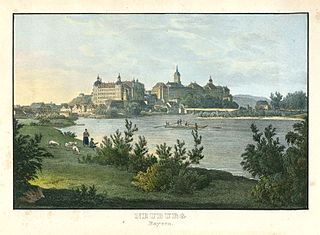
The Battle of Neuburg occurred on 27 June 1800 in the south German state of Bavaria, on the southern bank of the Danube river. Neuburg is located on the Danube between Ingolstadt and Donauwörth. This battle occurred late in the War of the Second Coalition (1798–1802), the second war between Revolutionary France and the conservative European monarchies, which included at one time or another Britain, Habsburg Austria, Russia, the Ottoman Empire (Turkey), Portugal and Naples. After a series of reverses, several of the allies withdrew from the Coalition. By 1800, Napoleon's military victories in northern Italy challenged Habsburg supremacy there. French victories in the upper Danubian territories opened a route along that river to Vienna.
















